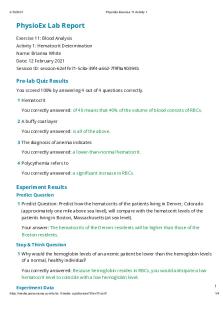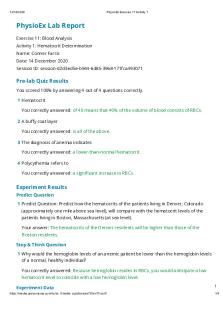Physio Ex Exercise 11 Activity 2 PDF

| Title | Physio Ex Exercise 11 Activity 2 |
|---|---|
| Author | Jennifer Martinez |
| Course | Human Anatomy and Physiology II |
| Institution | Hillsborough Community College |
| Pages | 3 |
| File Size | 59 KB |
| File Type | |
| Total Downloads | 74 |
| Total Views | 150 |
Summary
Download Physio Ex Exercise 11 Activity 2 PDF
Description
PhysioEx Lab Report Exercise 11: Blood Analysis Activity 2: Erythrocyte Sedimentation Rate Name: Jennifer Martinez Date: 27 May 2021 Session ID: session-4dd1c901-992b-f78c-21fe-ac79437381cd
Pre-lab Quiz Results You scored 100% by answering 3 out of 3 questions correctly. 1 The erythrocyte sedimentation rate (ESR) You correctly answered: is increased whenever fibrinogen and immunoglobulins cause the RBCs to clump together, stack up, and form a column. 2 The ESR cannot be used to follow the progression of which of the following diseases? You correctly answered: gingivitis. 3 The ESR can be used to evaluate a patient with You correctly answered: all of the above.
Experiment Results Predict Question 1 Predict Question: How will the sedimentation rate for sample 6 (individual with angina pectoris) compare with the sedimentation rate for sample 1 (healthy individual)? Your answer: It will be the same. Stop & Think Question 1 What is in the beige-colored portion of the sedimentation tube? You correctly answered: plasma. Experiment Data Blood sample
Distance RBCs have settled (mm)
Time elapsed (min)
Sedimentation rate (mm/hr)
1
5
60
5
2
15
60
15
3
0
60
0
4
30
60
30
5
40
60
40
6
5
60
5
Sample 1: healthy individual Sample 2: menstruating female Sample 3: individual with sickle cell anemia Sample 4: individual with iron-deficiency anemia Sample 5: individual suffering a myocardial infarction Sample 6: individual with angina pectoris
Post-lab Quiz Results You scored 100% by answering 3 out of 3 questions correctly. 1 The erythrocyte sedimentation rate (ESR) measures You correctly answered: the settling of RBCs in a vertical, stationary tube of whole blood during one hour. 2 An increase in the ESR is You correctly answered: associated with worsening of anemia. 3 To properly measure the ESR, you need You correctly answered: a 1-hour timer.
Review Sheet Results 1 Describe the effect that sickle cell anemia has on the sedimentation rate (sample 3). Why do you think that it has this effect? Your answer: Sickle cell anemia stops the sedimentation of whole blood because of the shape of the hemoglobin.
2 How did the sedimentation rate for the menstruating female (sample 2) compare with the sedimentation rate for the healthy individual (sample 1)? Why do you think this occurs? Your answer: The sedimentation rate was triple that of a healthy individual. This likely occurred because of the increased iron deficiency anemia during menstruation. 3 How did the sedimentation rate for the individual with angina pectoris (sample 6) compare with the sedimentation rate for the healthy individual (sample 1)? Why? How well did the results compare with your prediction? Your answer: My hypothesis was correct and the sedimentation rates are the same because angina does not cause an increased ESR. 4 What effect does iron-deficiency anemia (sample 4) have on the sedimentation rate? Your answer: It increases the ESR. 5 Compare the sedimentation rate for the individual suffering a myocardial infarction (sample 5) with the sedimentation rate for the individual with angina pectoris (sample 6). Explain how you might use this data to monitor heart conditions. Your answer: The sedimentation rate for the individual with myocardial infarction is significantly higher than the individual with angina. You can use this data to help determine if the patient is still in myocardial infarction or if their chest pains are related to angina....
Similar Free PDFs

Physio Ex Exercise 11 Activity 2
- 5 Pages

Physio Ex Exercise 11 Activity 2
- 3 Pages

Physio Ex Exercise 11 Activity 2
- 3 Pages

Physio Ex Exercise 11 Activity 2
- 3 Pages

Physio Ex Exercise 11 Activity 1
- 4 Pages

Physio Ex Exercise 11 Activity 1
- 4 Pages

Physio Ex Exercise 11 Activity 4
- 4 Pages

Physio Ex Exercise 11 Activity 1
- 4 Pages

Physio Ex Exercise 11 Activity 3
- 3 Pages

Physio Ex Exercise 11 Activity 4
- 4 Pages

Physio Ex Exercise 11 Activity 1
- 4 Pages

Physio Ex Exercise 11 Activity 5
- 3 Pages

Physio Ex Exercise 11 Activity 4
- 6 Pages

Physio Ex Exercise 11 Activity 3
- 3 Pages

Physio Ex Exercise 11 Activity 1
- 4 Pages

Physio Ex Exercise 2 Activity 2
- 11 Pages
Popular Institutions
- Tinajero National High School - Annex
- Politeknik Caltex Riau
- Yokohama City University
- SGT University
- University of Al-Qadisiyah
- Divine Word College of Vigan
- Techniek College Rotterdam
- Universidade de Santiago
- Universiti Teknologi MARA Cawangan Johor Kampus Pasir Gudang
- Poltekkes Kemenkes Yogyakarta
- Baguio City National High School
- Colegio san marcos
- preparatoria uno
- Centro de Bachillerato Tecnológico Industrial y de Servicios No. 107
- Dalian Maritime University
- Quang Trung Secondary School
- Colegio Tecnológico en Informática
- Corporación Regional de Educación Superior
- Grupo CEDVA
- Dar Al Uloom University
- Centro de Estudios Preuniversitarios de la Universidad Nacional de Ingeniería
- 上智大学
- Aakash International School, Nuna Majara
- San Felipe Neri Catholic School
- Kang Chiao International School - New Taipei City
- Misamis Occidental National High School
- Institución Educativa Escuela Normal Juan Ladrilleros
- Kolehiyo ng Pantukan
- Batanes State College
- Instituto Continental
- Sekolah Menengah Kejuruan Kesehatan Kaltara (Tarakan)
- Colegio de La Inmaculada Concepcion - Cebu